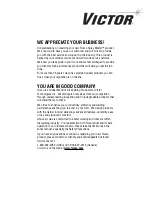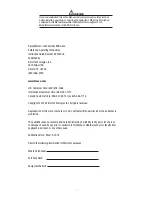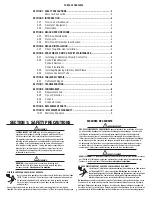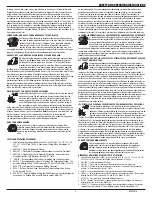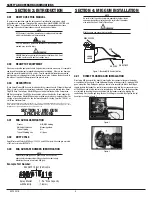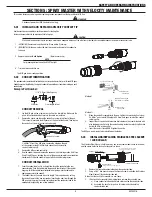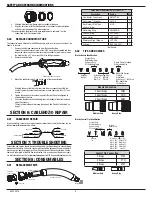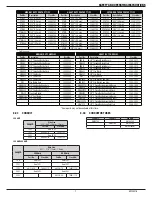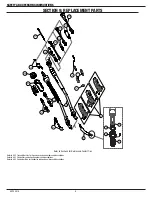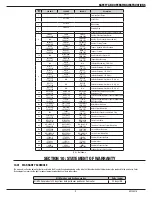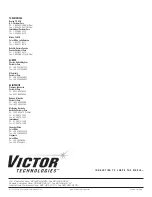
SAFETY AND OPERATING INSTRUCTIONS
5
89200016
SECTION 5: SPRAY MASTER WITH VELOCITY MAINTENANCE
This section discusses servicing and or replacing various components of the Spray Master MIG Gun.
WARNING
Disconnect power from MIG Gun before servicing.
5.01
INSTALLING OR REPLACING VELOCITY CONTACT TIP
Avoid excessive consumables wear by periodically rotating tips.
Increase consumables life by occasionally rotating tips.
CAUTION
While nozzle and contact tip are removed, maintain an adequate distance of the wire from metal objects to avoid burnbacks to conduit or conductor tube.
1. (REPLACING) Remove worn nozzle and tip. (Clean nozzle if reusing.)
2. (NEW INSTALL) Slide new contact tip over the conduit end and into the conductor
tube end.
3. Replace the nozzle.
Hand tighten
(Nozzle secures tip).
NOTE
For proper operation the nozzle MUST be tight.
4. Trim wire to desired stick out.
The MIG gun is now ready operation.
5.02 CONDUIT IDENTIFICATION
The procedure for removal and installation of a wire conduit is similar for all Tweco MIG guns.
Conduits may be identified by the type of conduit stop and the part number marking on each
conduit stop.
Example Part Number:
44-116-15
44 Series
1/16" (1,6mm) Wire Capacity
Liner length in feet
CONDUIT REMOVAL
1. Lay the MIG gun out on a table or on the floor in a straight line. Make sure the
gun is fully extended and all twists in the cable are removed.
2. Remove the nozzle and loosen the conduit set screw in the front of the gun.
This is usually located in the diffuser, or at the front of the handle. Then loosen
the conduit set screw in the rear connector plug.
Conduit set screw
NOTE
On Miller
®
Direct Plug MIG guns, remove the nipple on the end
of the connector plug. On Euro-Kwik connections, remove the
conduit retaining cap.
3. Remove the diffuser and contact tip.
4. Grip the conduit stop and remove the conduit with a twisting motion. On Miller
®
Direct Plug MIG guns, twisting the rear of the gun approximately one revolution
clockwise will raise the conduit stop out of the connector plug recess.
CONDUIT INSTALLATION
1. Uncoil the conduit and lay it in a straight line. Insert the conduit into the rear
connector plug. Push the conduit into the gun with short strokes. If the conduit
hangs up, twist the conduit counterclockwise or gently whip the cable while
applying pressure to the conduit.
2. The conduit liner will need to be cut to length. This can be done by cutting
the conduit to match the one removed or inserting the new liner through the
MIG gun and trimming the conduit extending from the conductor tube to the
appropriate length using one of two methods.
Stainless Steel
Sleeve end
Score on nozzle end
Nozzle
CUT
Method I
CUT
Conduit Trim Length
3/8” (9 mm to 10 mm)
Stainless Steel
Sleeve end
Method II
3. When the conduit is completely in the gun, tighten the rear conduit set screw.
On Miller
®
guns, reinstall the nipple. On Euro-Kwik guns, reinstall the conduit
retaining cap.
4. Inspect the cut conduit end to remove burrs because they could interfere with
wire feeding or conflict with the conduit seating inside the velocity tip. Remove
burrs with a file or side cutter.
5. Insert the contact tip and HAND tighten the nozzle.
The MIG gun is now ready to be reinstalled on the feeder.
5.03
INSTALLING/REPLACING STAINLESS STEEL SLEEVE
/ LOCK COLLAR
The Stainless Steel Sleeve is held in place by one screw (some models have two screws)
and the sleeve holds the lock collar assembly in place.
SCREW (SLEEVE)
Lock collar and wave spring are held
in place by the stainless steel sleeve.
STAINLESS STEEL SLEEVE
CONDUCTOR TUBE END
Tighten until screw head bottoms out.
1. Remove the front end consumables from the conductor tube.
2. Using a 5/64" Hex wrench remove the Sleeve Screw(s) and slide the Stainless
Steel Sleeve off the conductor tube end.
Notice that the Lock Collar assembly is now loose.
3. If the Lock Collar assembly is being replaced, remove the assembly now.
a) Clean conductor tube end and lock collar seat on the conductor tube.
b) Assemble the Lock Collar parts in this order and slide onto the
conductor tube end.


